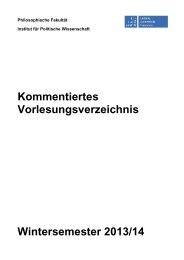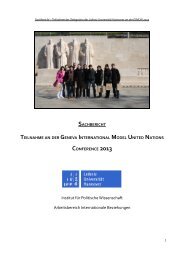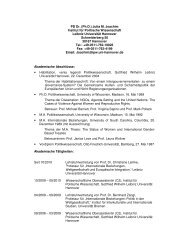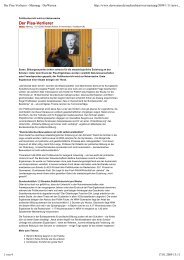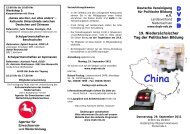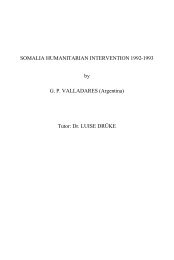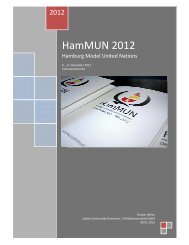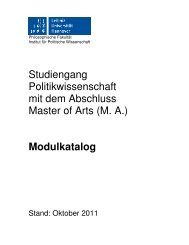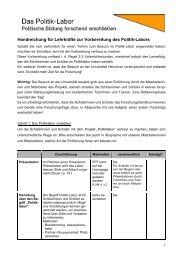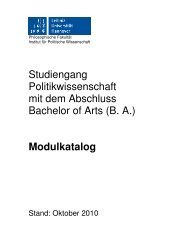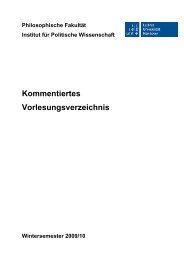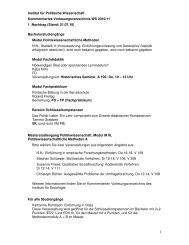Preventive Action for Refugee Producing Situations
Preventive Action for Refugee Producing Situations
Preventive Action for Refugee Producing Situations
You also want an ePaper? Increase the reach of your titles
YUMPU automatically turns print PDFs into web optimized ePapers that Google loves.
118 Chapter 3<br />
We understand from Professor Martin Diskin that there were<br />
indications to consider integrating some 50,000 Indians from Nicaragua as<br />
"pioneers" <strong>for</strong> the economic development of the Mosquitia, which may<br />
have contributed to plans to rather relocate them within the Atlantic Coast<br />
of Honduras instead of allowing them to repatriate voluntarily. 265<br />
But one of the main problems was that the "old" refugees did not want<br />
to be relocated, and the new arrivals were under strong pressure remain<br />
within the reach of the border area, so as to be able to keep collecting their<br />
food rations at the refugee locations.<br />
UNHCR had a major problem with the diversion of food destined <strong>for</strong><br />
refugees to recipients outside the refugee areas. There were constant<br />
complaints of food shortages, and the amount of rations actually needed in<br />
the refugee locations was usually far above the amount calculated foil the<br />
number of people counted in the official census. 266 Stricter administrative<br />
measures, such as keeping systematic count of the actual beneficiaries,<br />
were initiated by the new World Relief Director in June 1985; they have<br />
helped to maintain control of these assistance problems to some extent<br />
Analysis of the three major causes of the Miskito influx<br />
"Induced asylum": Although the interviewees did not explicitly say that<br />
they had been <strong>for</strong>cibly evacuated into Honduras, they confirmed that a<br />
large group was being prepared to follow them. In<strong>for</strong>mation collected be<strong>for</strong>e,<br />
during, and after the interviews made it clear that a large number of<br />
people had no choice whether or not to cross the Coco River. As<br />
predicted, approximately 8,500 Nicaraguan Indians entered Honduras<br />
during Easter week of 1986. 267 Although William Casey, then director of<br />
____________________<br />
265 Interview with Martin Diskin , Professor at the M.I.T., Cambridge, USA on<br />
14 October 1988.<br />
266 According to interviews done by human rights workers with repatriatees in<br />
Nicaragua in November 1986, the interviewees complained that there was<br />
not enough food in Honduras. They also complained that KISAN was a<br />
constant bother; although UNHCR kept the armed KISAN out of the camps,<br />
they nevertheless came in in civilian clothes (and took their food away).<br />
267 Martin Diskin, an authority on indigenous questions and Anthropology<br />
Professor at MIT, interviewed a group of repatriating Miskitos in the<br />
holding camp in Leon, Nicaragua, in July 1986. All said that they were<br />
taken across ("led," "kidnapped," "crossed" were their words) by KISAN .<br />
By the same token, journalists from the Philadelphia Inquirer and the<br />
Boston Globe had found that KISAN had spread<br />
Analytical Discussion 119<br />
the Central Intelligence Agency (CIA), and Elliot Abrams, Assistant Secretary of<br />
State <strong>for</strong> Inter-American Affairs, tried to blame this movement of Miskito people<br />
on Sandinista atrocities, independent observers found "evidence lacking of new<br />
Sandinista abuses that caused their flight." Rather, they found that "KISAN had<br />
spread fear as part of a deliberate plan to evacuate the Miskitos to Honduras." 268<br />
Interviews done by a human rights workers confirmed that KISAN had "crossed<br />
them over." 269<br />
This <strong>for</strong>cible relocation of 8,500 at one blow, similar to actions in other villages<br />
such as Francia Sirpe, was undertaken solely to create a stir in international public<br />
opinion, in gross violation of common article three of the Geneva Convention. 270<br />
What investigators of this case found most disturbing was the callousness with<br />
which KISAN and others exploited<br />
fear as part of a deliberate plan to evacuate the Miskitos from Nicaragua to Hon-duras.<br />
Diskin, "The Manipulation of Indigenous Struggles," p. 90.<br />
268 Diskin et al., "Peace and Autonomy on the Atlantic Coast of Nicaragua," September 1986,<br />
p. 24.<br />
269 Human rights workers visited the Coco River area in Nicaragua on 21-24 November,<br />
1986 <strong>for</strong> a fact-finding mission, which included interviews with returnees of the "new"<br />
refugees who had already returned from Honduras, either spontaneously or, when KISAN<br />
had prevented it, with UNHCR's assistance. The people they talked with on the Coco River<br />
mentioned several human rights violations that KISAN was guilty of, and none by the<br />
Nicaraguan governmental <strong>for</strong>ces. The most serious complaint was the <strong>for</strong>cible evacuation<br />
of the Coco River communities to Honduras during the Easter week. Not only had KISAN<br />
"crossed" them over, but all those who had already repatriated from Honduras and did not<br />
want to return there again were <strong>for</strong>ced by KISAN to do so. The human rights workers<br />
mentioned the case of one Miskito Indian who permitted his name to be used: Franklin<br />
Vincent, 54, from San Carlos on the Coco River. After having been <strong>for</strong>cibly evacuated to<br />
Sumubila (in Taspa Pri) by the Nicaraguan Government in 1982, he had returned to his<br />
village San Carlos in February 1986, where he lived quietly <strong>for</strong> two months until in April<br />
KISAN <strong>for</strong>ced him into Honduras. He said KISAN came to take them away, telling them<br />
only that they "had" to leave, and giving no other explanation. Those who opposed this<br />
relocation would be punished and were taken by <strong>for</strong>ce. In their interviews, the human rights<br />
workers found a familiar refrain among the repatriees: "because KISAN crossed them<br />
over", 'they came,' 'they took our food.' "They" meant "los Kisanes."<br />
270 Additional Protocol H, June 6, 1977, Article 17, relating to non-international armedconflicts<br />
of the four Geneva Conventions of August 12, 1949, prohibits the <strong>for</strong>cible<br />
displacement of civilian populations, unless the security of the civilians concerned, or<br />
imperative military reasons, so demand. Neither condition had been met by KISAN in the<br />
<strong>for</strong>cible evacuation of 8,500 Indians from the Coco River into Honduras at Easter 1986.<br />
See Francoise Bory, Origin and Development of the International Humanitarian Law<br />
(Geneva: International Committee of the Red Cross, Geneva, 1982), p. 37.



